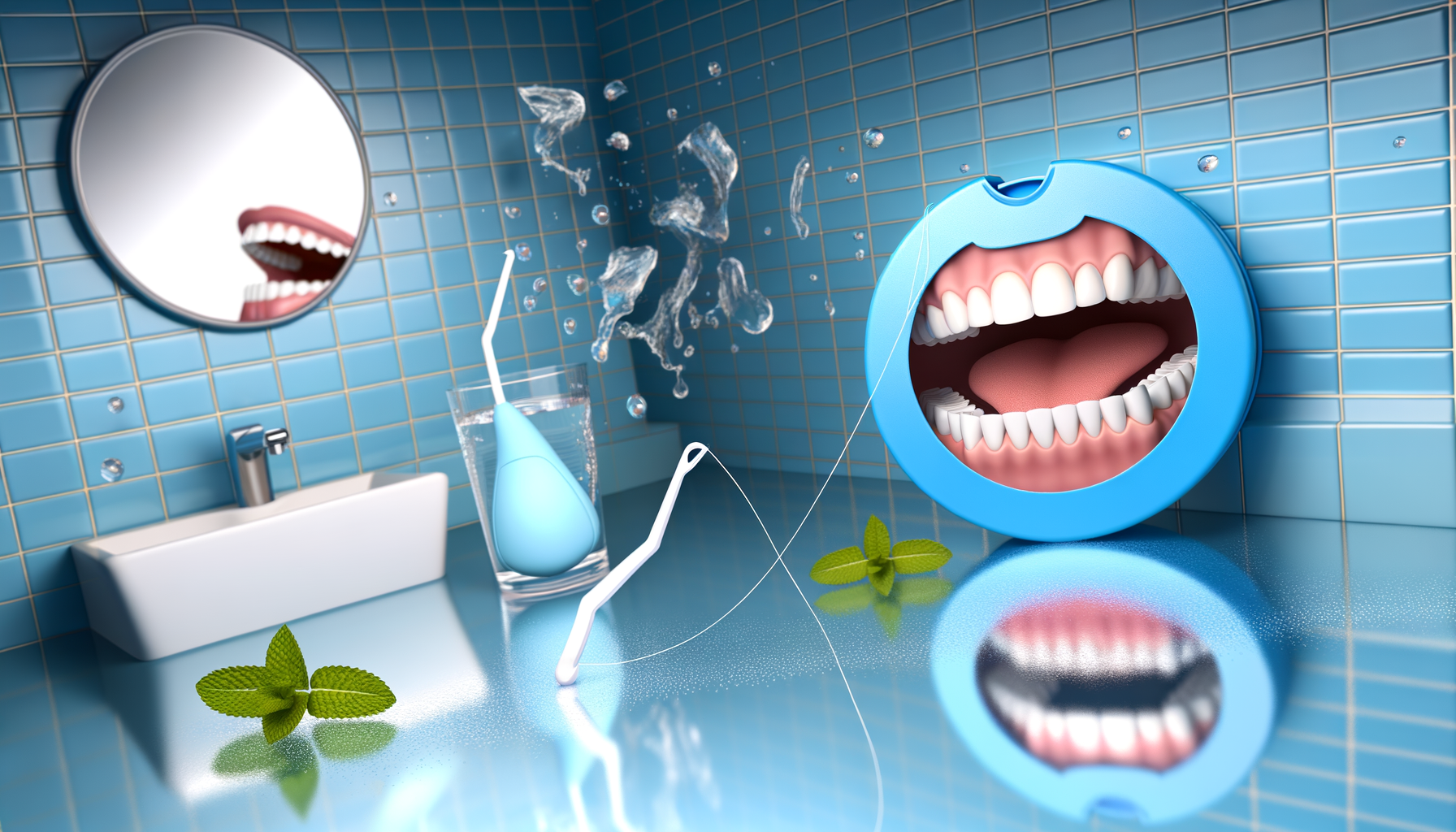Flossing Decoded: Why It's Essential for Your Oral Health

Flossing, often overlooked, plays a critical role in our daily oral health routine. Despite common misconceptions, this simple act does more than just remove food remnants stuck between our teeth. It's a pivotal weapon in our arsenal against oral health issues.
The Benefits of Flossing
When it comes to oral health, there's a tiny yet mighty instrument that doesn't always get the credit it deserves: dental floss. Beyond the toothbrush's reach, flossing defends your teeth and gums against the sneaky culprits of decay and disease. So let's unravel the story of flossing and understand how this slender thread keeps your smile in top form.
Removal of Plaque and Bacteria
Have you ever considered what happens to the food particles that linger after you eat? They mingle with saliva and naturally occurring bacteria in your mouth, forming a sticky but clear substance known as plaque. This isn't make-believe; it's the precursor to many oral health issues. Floss not only disrupts the party plaque that is thrown between your teeth but also gives bacteria the boot before it invites cavities and gum disease to the mix. Here's the secret: while your toothbrush works wonders on the surfaces of your teeth, floss is the champion of the tight spaces it can't reach.
The relationship between bacteria, plaque, and dental diseases is a tumultuous one. A buildup of plaque can lead to tartar, a hardened form of plaque that no amount of brushing and flossing can remove—only professional cleanings can address it. If left unchecked, this buildup can evolve into gingivitis, the earliest stage of gum disease.
Prevention of Gum Disease
Imagine your gums as the cozy bed for your teeth. Keeping this bed tidy with regular flossing can prevent unwanted guests like gingivitis from settling in. If neglected, gingivitis can turn into periodontitis - a more severe inflammation around the teeth. Here in Salt Lake City, just like in any other place, the prevalence of gum disease can sneak up on anyone, affecting not just oral health but also overall wellness. There's a well-documented link between periodontal diseases and other chronic conditions such as diabetes, heart disease, and strokes.
The American Dental Association (ADA) recommends flossing as a daily part of your oral hygiene routine to guard against these risks. But what about the occasional spot of blood you might see on your floss? That might be a tell-tale sign of gingivitis, indicating the need to pay a bit more attention to those particular areas rather than avoiding them. Regular flossing can often reverse this early stage of gum disease.
Prevention of Tooth Decay
Stepping into the ring against tooth decay, flossing serves as a critical defensive maneuver to protect the spaces between your teeth, where a toothbrush's bristles often can't reach. An unassuming crevice can hide a speck of food that ferments into an acidic hotspot, leading to cavities. Interdental cleaning, or what we commonly call flossing, ensures that these potential cavity-causing leftovers don't stand a chance against your dental diligence.
For the community here in Downtown Salt Lake City, regular flossing is just as vital as any other health routine. By preventing tooth decay, we're able to maintain not just a brighter smile, but also a foundation for overall health and well-being.
Contribution to Fresh Breath
Now, let's talk about something that everyone appreciates – fresh breath. It's no myth that bad breath, or halitosis, can stem from food particles that linger in your mouth. These uninvited leftovers break down and can give rise to odorous compounds. Flossing removes these particles, along with the bacteria that feast on them, helping you maintain that clean, fresh breath that makes conversations up close a lot less worrisome.
The Correct Flossing Technique
Perhaps you've wondered if you're flossing the right way, or if there indeed is a "right way" – there is, and it goes beyond haphazardly popping a string between your teeth. The technique matters because done incorrectly, you might miss the benefits, or worse, harm your gums.
Types of Dental Floss
There's more to floss than the minty string that comes to mind. There's traditional string floss, a favorite for its precision and ease of control, and there's dental tape, a broader and flatter option that's often lauded for its comfort, especially meant for those with a bit more space between their teeth.
Then, the water flosser enters the scene – a device that cleans between your teeth with a jet of water, highly recommended for those with braces or other dental work
where traditional floss might struggle.
Step-by-Step Flossing Guide
The magic of flossing lies in the details. Start with about 18 inches of floss, winding most of it around one middle finger and the rest around the other, leaving an inch or two to work with. Holding the floss tautly between your thumbs and index fingers, gently guide it between your teeth in a zig-zag motion. Curve the floss around each tooth in a "C" shape and move it up and down gently against the side of each tooth, including under the gumline. Unwind fresh floss as you proceed to the next tooth.
If you're in doubt or want to ensure you're doing it the right way, it's always a good idea to ask your dental care provider for a quick tutorial during your next visit. We, as Salt Lake City residents, need to cater to our unique dental needs that arise from our lifestyle choices and even the climate we live in.
Common Flossing Mistakes to Avoid
Flossing is kind of like dancing – there's a rhythm to it. But, just as with dancing, it's easy to step out of tune without realizing it. Some typical missteps include snapping the floss too hard, leading to tender cut gums, or flossing too vigorously, which can cause unnecessary wear and tear to the delicate tissue. Another oversight is flossing only the front teeth, assuming those are the ones that matter most. Truth is, decay doesn't discriminate; it's just as likely to occur in the back of your mouth as in the front. So when you floss, be gentle and remember every nook is of equal importance.
For residents of Salt Lake City, the arid climate can also influence oral health, making tissues more prone to sensitivity or bleeding. If you find flossing to be uncomfortable, speak to your dentist – they're there to help guide you to flossing techniques that are as kind to your gums as they are effective at cleaning your teeth.
Overcoming Challenges and Myths About Flossing
The path to optimal dental health isn't always clear-cut. Misunderstandings can spring up, leading to hesitation or neglect in your flossing routine, but let's tackle those head-on.
Addressing Specific Flossing Challenges
If you've got braces, bridges, or crowns, you might think flossing is too much trouble. However, these dental treatments should not be a barrier to your oral hygiene. Tools like floss threaders and interdental brushes are your allies, designed to navigate the wire landscapes and nooks with ease.
For those with sensitive gums – maybe they bleed a bit when you floss – the culprit could be inflammation due to plaque buildup or even gentle irritation. Rather than putting down the floss, try using a softer hand and speak with your dental professional about proper technique and tips for reducing sensitivity.
Debunking Myths
Let's set the record straight on a couple of common flossing fallacies. "Flossing is optional," some say. But, think of flossing as the trusty sidekick to your toothbrush – it reaches the areas your brush can't and takes your oral hygiene to the next level.
Then there's the notion that "bleeding means you should stop flossing." If your gums bleed when you floss, it could be a sign that they need more attention, not less. Persistent bleeding should, however, be a cue to consult your dentist in Salt Lake City to rule out issues that require professional care.
Flossing in the Context of a Complete Dental Care Routine
Harmony in dental care means integrating flossing into a daily regimen that includes brushing and using mouthwash. It's a trio that sings better together, protecting your oral health from all angles. Remember, a quick swish of mouthwash alone can't dislodge the stubborn particles that floss targets, and a toothbrush, no matter how adeptly used, can't quite finesse its way into every interdental space.
Amidst the skyline of Salt Lake City, whether at home or during regular dental visits, flossing is an unsung hero in avoiding plaque buildup and ensuring that professional cleanings are less about damage control and more about maintenance.
Pediatric Flossing: Instilling Good Habits Early
When it comes to setting children on the path to a lifetime of healthy smiles, flossing plays a significant role. Teach them young with techniques that make flossing fun and approachable. Use flossers designed for small hands or turn the process into a game, all while underscoring the value of a thorough clean. Parents and guardians in the Salt Lake community are the first line of defense in nurturing these habits, shaping the dental future of the next generation.
Common Questions and Expert Answers
How often should you floss? Daily, according to dental professionals. And can flossing too much be harmful? If done correctly, frequent flossing is a boon, but if your technique is too aggressive, it might irritate or damage your gums. If you have concerns or questions about flossing's effectiveness, bring it up with your dentist – they're the resource you need for advice tailored to your oral health.
Supporting Your Oral Health Journey: The Role of Your Dental Team
Understanding that your dental health journey is personal and evolves, regular visits to your dental team can significantly support your flossing efforts. A hygienist can provide insights into your technique, offer personalized advice, or recommend products that will suit your teeth's spacing and sensitivity. Having a dental professional in Salt Lake City, someone familiar with your dental history and local environment is invaluable for ongoing oral healthcare.
So there you have it, a close look at why flossing deserves a standing ovation in the playbill of your dental health. Take proactive steps, and don't shy away from any questions you might have during your next dental appointment – after all, flossing is a key player, but it's the teamwork between you and your dental provider that leads to encore-worthy oral health.
South Temple Dental in Downtown Salt Lake City is your home for comprehensive dental care. If you desire a dental partner who champions education and choice, we're ready to welcome you.


